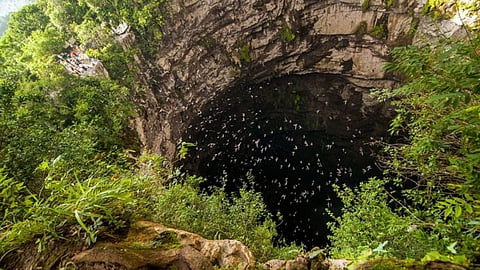
- முகப்பு
- கல்கி
- மங்கையர் மலர்
- தீபம்
- கோகுலம்/Gokulam
- முக்கிய பிரிவுகள்முக்கிய பிரிவுகள்
- தொகுப்புகள்தொகுப்புகள்
- Premium

The Cave of Swallows, known as 'Cueva de las Golondrinas' in Spanish, is one of the world's largest open-air caves located in San Luis Potosí, Mexico. It is famous for its natural beauty and significant ecological features.
1. Dimensions: It is approximately 370 meters (1,214 feet) deep, 145 meters (476 feet) wide at the opening. It has a vertical drop that creates a stunning view from the top.
2. Ecology: It is home to a variety of bats, particularly the Brazilian free-tailed bats. They can be seen coming out in large numbers at dusk. The sight of thousands of bats flying out of the cave can be an amazing experience.
3. Tourism: It attracts adventure seekers and tourists who often go base jumping from its high cliffs. Its unique geography and natural beauty make it a popular destination for photographers and nature enthusiasts.
4. Cultural Significance: It has also been a site for local folklore and is associated with various legends. It plays a role in the cultural heritage of the region.
5. Community impact: The influx of tourists to the Cave of Swallows has positively impacted the local economy. It provides job opportunities for residents in the form of guiding services, hospitality, and local crafts.
6. Access: Visitors can reach the cave via a series of hiking trails or guided tours, which often include information about the cave's geology and ecology.
7. Wildlife Watching: Visitors often go to the cave not only to see bats but also to observe thousands of birds that inhabit the area. Early mornings and evenings are particularly good times for wildlife watching.
8. Photography and Film making: The dramatic scenery and unique light conditions inside and around the cave make it a popular spot for photographers and filmmakers. Many documentaries and travel shows feature the cave due to its striking visuals.
9. Cultural Events: Local festivals sometimes incorporate visits to the Cave of Swallows, highlighting the cultural significance of the region and providing a chance to celebrate local traditions.
10. 27 December 1966 – The world’s longest cave ‘Cave of Swallows’ was discovered in Aquismon, Mexico. The Cave of Swallows is a testament to the natural wonders that can be found around the world, offering unique experiences for those who visit.
